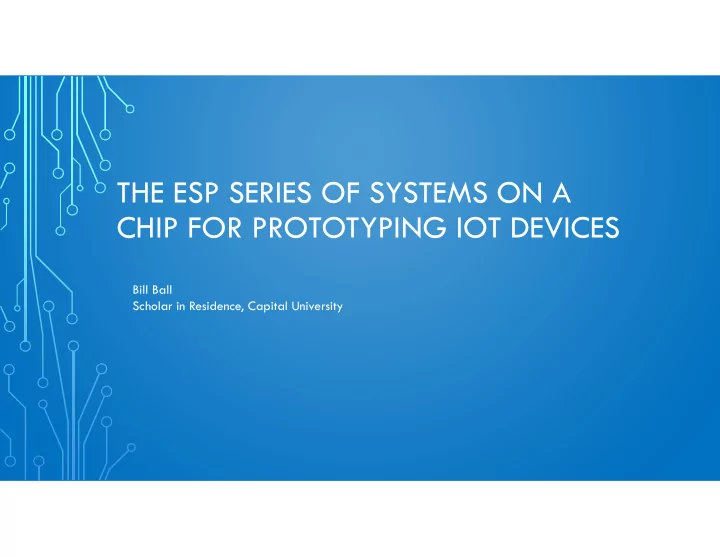

THE ESP SERIES OF SYSTEMS ON A CHIP FOR PROTOTYPING IOT DEVICES Bill Ball Scholar in Residence, Capital University
WHAT YOU WILL HAVE TO SIT THROUGH WHILE SECRETLY CHECKING YOUR PHONE • The ESP in context • Details of the ESP32 and Lolin D32 Pro • Pros and Cons of the D32 Pro for learning micros • Demos and play time -- tell me what I have missed (If you’re just too ADD for this, go to http://robot50.net/workshops/esp32-workshop/ and start playing with the board)
THE ESP IN CONTEXT – MICRO PLATFORM ASPIRATIONS FOR INTRO TO RAPID PROTOTYPING COLLEGE CLASS 1. Suitable for complete beginnings to intermediate level complete prototypes 2. Flexibility in programing languages 3. Open-ish source-ish 4. Cheap 5. Well supported with tutorials, community, and cheap external sensors and accessories (in breadboardable form) 6. Rugged and easy to mount in 3D printed projects 7. Simple set up 8. Connected
THE ESP IN CONTEXT – A RANGE OF POSSIBILITIES Arduino Raspberry Pi
THE ESP IN CONTEXT – A RANGE OF POSSIBILITIES
THE ESP IN CONTEXT – A RANGE OF POSSIBILITIES
THE ESP IN CONTEXT – A RANGE OF POSSIBILITIES
THE ESP32 . . .but first a relaxing interlude. . .
THE ESP32 Processors: CPU: Xtensa dual-core (or single-core) 32-bit LX6 microprocessor, operating at 160 or 240 MHz and performing Security : IEEE 802.11 standard security features all supported, at up to 600 DMIPS including WFA, WPA/WPA2 and WAPI, Secure boot, Flash encryption, 1024-bit OTP , up to 768-bit for customers, Wireless connectivity: Wi-Fi: 802.11 b/g/n Bluetooth: v4.2 Cryptographic hardware acceleration: AES, SHA-2, RSA, elliptic BR/EDR and BLE curve cryptography (ECC), random number generator (RNG) Peripheral interfaces: 12-bit SAR ADC up to 18 channels Power management: Internal low-dropout regulator, Individual 2 × 8-bit DACs power domain for RTC, 5 μ A deep sleep current 10 × touch sensors (capacitive sensing GPIOs) Wake up from GPIO interrupt, timer, ADC measurements, 4 × SPI capacitive touch sensor interrupt 2 × I²S interfaces 2 × I²C interfaces 3 × UART SD/SDIO/CE-ATA/MMC/eMMC host controller SDIO/SPI slave controller Ethernet MAC interface with dedicated DMA and IEEE 1588 Precision Time Protocol support CAN bus 2.0 Infrared remote controller (TX/RX, up to 8 channels) Motor PWM, LED PWM (up to 16 channels) Hall effect sensor Ultra low power analog pre-amplifier
THE ESP32 – WEMOS/LOLIN D32 PRO Espressif official ESP32-WROVER module 16MB Flash, 8MB PSRAM or 4MB Flash, 4MB PSRAM Clock Speed(Max) 240Mhz @ 68 mA, 5 uA in deep sleep mode WIFI & Bluetooth Lithium battery interface, 500mA Max charging current Battery Connector: PH-2 2.0mm LOLIN I2C port LOLIN TFT port TF (Micro SD) Card slot, supports SPI mode. Board Power Supply (USB) 5V Supported Batteries Lipo Battery 3.7V Operating Voltage 3.3V Digital I/O Pins 21 (total) 12 bit ADC Analog Input Pins 6 (total) Analog Output Pins (DAC) 2 PWM Pins 2 All of the IO pins run at 3.3V, up to 40ma USB 5V available @ .68a Length 65mm Width 25.4mm Weight 7.5g
DOES THE D32 PRO MEET ASPIRATIONS? 1. Suitable for complete beginnings to intermediate level complete prototypes 2. Flexibility in programing languages: Arduino, Micro-Python, C (Espressif IDF) 3. Open-ish source-ish: good Espressif docs, Arduino port plus commodity sensors 4. Cheap: $9.80 (Pro with 16MB), $6.50 (D32 with 4MB), $6.70 TFT & cable 5. Well supported with tutorials, community, and cheap external sensors and accessories (in breadboardable form) 6. Rugged and easy to mount in 3D printed projects: 2x2mm, 1x2.?mm holes, small and rectangular, silk screened both sides, flat bottom, but no damn on/off switch 7. Simple set up: possibly drivers and several libraries to install in Arduino IDE 8. Connected: wifi & Bluetooth, BLE HID on iOS!
D32 PRO / ESP8266 PLAYTIME • To get started: http://robot50.net/workshops/esp32-workshop/ • Quirks & things that need work: • Cannot use SD card with TFT attached using normal libraries • More complete HID examples • Simplified network logons • No damn on/off switch
Recommend
More recommend